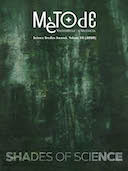Humans 2.0: Escrivint el futur de l’evolució humana
DOI:
https://doi.org/10.7203/metode.10.12554Paraules clau:
seqüenciació del genoma, edició genètica, modificació genètica humana, determinisme genètic, bioètica Resum
Resum
Podrem els humans dirigir l’evolució futura de la nostra espècie? Basant-nos en els coneixements actuals en genètica, es pot inferir i extrapolar què pot passar en un futur més proper. Al cap i a la fi, si cal predir el futur, cal comprendre les bases del nostre present. Per respondre la pregunta inicial, presentaré breument què sabem sobre el nostre genoma i si tenim prou dades per inferir com som (el que s’anomena correlació genotip-fenotip), per passar a presentar els avenços tecnològics actuals i el seu impacte potencial en la nostra evolució.
 Descàrregues
Descàrregues
 Referències
Referències
Apte, R. S. (2018). Gene therapy for retinal degeneration. Cell, 173(1), 5. doi: 10.1016/j.cell.2018.03.021
Beans, C. (2018). Science and culture: Wearable tech meets tattoo art in a bid to revolutionize both. Proceedings of the National Academy of Sciences of the USA, 115(14), 3504–3506. doi: 10.1073/pnas.1803214115
De Lecuona, I., Casado, M., Marfany, G., López-Baroni, M., & Escarrabill, M. (2017). Gene editing in humans: Towards a global and inclusive debate for responsible research.
Yale Journal of Biology and Medicine, 90(4), 673–681. PMID: 29259532
Gaskell, G., Bard, I., Allansdottir, A., Vieira da Cunha, R., Eduard, P., Hampel, J., ... Zwart, H. (2017). Public views on gene editing and its uses. Nature Biotechnology, 35, 1021–1023. doi: 10.1038/nbt.3958
Gerbault, P., Liebert, A., Itan, Y., Powell, P., Currat, M., Burger, J. ... Thomas, M. J. (2011). Evolution of lactase persistence: An example of human niche construction. Philosophical Transactions of the Royal Society of London B Biological Sciences, 366(1566), 863–877. doi: 10.1098/rstb.2010.0268
Hirsch, T., Rothoeft, T., Teig, N., Bauer, J. W., Pellegrini, G., De Rosa, L. ... De Luca, M. (2017). Regeneration of the entire human epidermis using transgenic stem cells. Nature, 551, 327–332. doi: 10.1038/nature24487
Kalia, S. S., Adelman, K., Bale, S. J., Chung, W. K., Eng, C., Evans, J. P. ... Miller, D. T. (2017). Recommendations for reporting of secondary findings in clinical exome and genome sequencing, 2016 update (ACMG SF v2.0): A policy statement of the American College of Medical Genetics and Genomics. Genetics in Medicine, 19(2), 249–255. doi: 10.1038/gim.2016.190
Ku, C. S., Polychronakos, C., Tan, E. K., Naidoo, N., Pawitan, Y., Roukos, D. H. ... Cooper D. N. (2013). A new paradigm emerges from the study of de novo mutations in the context of neurodevelopmental disease. Molecular Psychiatry, 18(2), 141–153. doi: 10.1038/mp.2012.58
Lim, E. T., Uddin, M., De Rubeis, S., Chan, Y., Kamumbu, A. S., Xhang, X., ... Walsh, C. A. (2017). Rates, distribution and implications of postzygotic mosaic mutations in autism spectrum disorder. Nature Neuroscience, 20, 1217–1224. doi: 10.1038/nn.4598
McCullough, J. M., Heath, K. M., & Smith, A. M. (2015). Hemochromatosis: Niche construction and the genetic domino effect in the European Neolithic. Human Biology, 87(1), 39–58. PMID: 26416321
Mojica, F. J. M., & Montoliu, L. (2016). On the origin of CRISPR-Cas technology: From prokaryotes to mammals. Trends in Microbiology, 24(10), 811–820. doi: 10.1016/j.tim.2016.06.005
Montoliu, L., Merchant, J., Hirsch, F., Abecassis, M., Jouannet, P., Baertschi, B., ... & Chneiweiss, H. (2018). ARRIGE arrives: Toward the responsible use of genome editing. The CRISPR Journal, 1(2), 128–129. doi: 10.1089/crispr.2018.29013.mil
Roukos, D. H. (2014). Innovation versus evidence: To trust direct-to-consumer personal genomic tests? Expert Review of Molecular Diagnostics, 11, 1–4. doi: 10.1586/erm.10.99
Santander, N. G., Contreras-Duarte, S., Awad, M. F., Lizama, C., Passalacqua, I., Rigotti, A., & Busso, D. (2013). Developmental abnormalities in mouse embryos lacking the HDL receptor SR-BI. Human Molecular Genetics, 22(6), 1086–1096. doi: 10.1093/hmg/dds510
The 1000 Genomes Project Consortium. (2015). A global reference for human genetic variation. Nature, 526, 68–74. doi: 10.1038/nature15393
Vernot, B., & Pääbo, S. (2018). The predecessors within... Cell, 173(1), 6–7. doi: 10.1016/j.cell.2018.03.023
Wang, H., La Russa, M., & Li, Q. S. (2016). CRISPR/Cas9 in genome editing and beyond. Annual Reviews in Biochemistry, 85, 227–264. doi: 10.1146/annurev-biochem-060815-014607
Descàrregues
Publicades
Com citar
-
Resum6812
-
PDF 826
Número
Secció
Llicència
![]()
Tots els documents inclosos en OJS són d'accés lliure i propietat dels seus autors.
Els autors que publiquen en aquesta revista estan d'acord amb els següents termes:
- Els autors conserven els drets d'autor i garanteixen a la revista el dret a la primera publicació del treball, llicenciat baix una llicència de Reconeixement-NoComercial-SenseObraDerivada 4.0 Internacional de Creative Commons, que permet a altres compartir el treball amb un reconeixement de l'autoria del treball i citant la publicació inicial en aquesta revista.
- Es permet i s'anima els autors a difondre la versió definitiva dels seus treballs electrònicament a través de pàgines personals i institucionals (repositoris institucionals, pàgines web personals o perfils a xarxes professionals o acadèmiques) una vegada publicat el treball.





